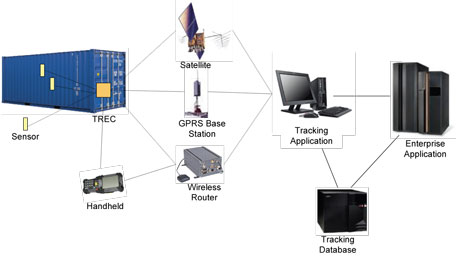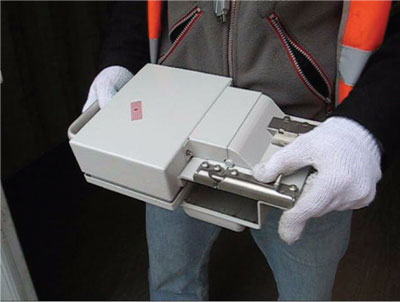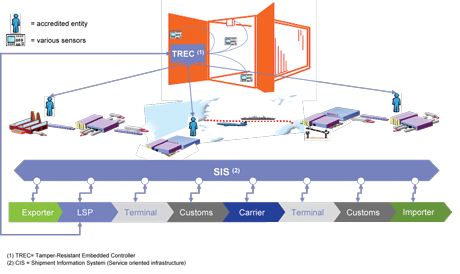by Francois Dolivo
The IBM Secure Trade Lane (STL) is a new comprehensive global logistics information platform. It gives global supply-chain stakeholders access to information on demand, allowing real-time access and response to physical cargo monitoring data as well as the related logistics transaction data. For the first time, shipments can be monitored from the manufacturer to the store and related activities such as port operations optimized.
The international shipping industry plays a key part in the global economy. It is responsible for the carriage of 90% of world trade, with 50,000 merchant ships annually transporting over six billion tons of goods in some twenty million maritime containers. Without shipping, intercontinental trade, the transport of raw materials, manufactured goods and food would simply not be possible.
In this age of 'just-in-time' manufacturing and supply, containers are virtual warehouses that move goods from origin to destination via an intricate set of processes. These often involve more than ten different service providers, government representatives or intermediaries. Market and customer pressures demand that these complex operations be optimized, and this has implications for both public and private parties in the trade lane. Governments are therefore under pressure to improve clearance speeds and reduce costs. In addition, security must be drastically improved in this time of increased terrorist threats and security breaches: currently only 2-4 % of transported containers are physically inspected. These needs are driving changes in public policy that will affect the entire industry, with new challenges arising in terms of security, reliability, liability, visibility, and efficiency of container shipment.


The IBM Secure Trade Lane (STL) is a new comprehensive global logistics information platform that addresses all these challenges by providing unprecedented levels of supply chain efficiency and security. It gives global supply-chain stakeholders access to information on demand, allowing real-time access and response to physical cargo monitoring data, and related logistics transaction data such as order information, invoices, financial data, bills of lading and manifests.
An overall view of the STL architecture is shown in Figure 1. At its heart is the TREC (Tamper-Resistant Embedded Controller), an intelligent wireless monitoring device (see Figure 2) that is mounted on the container. Information provided by TRECs is made available to supply chain participants through the Shipment Information System (SIS; see Figure 3). The SIS is a distributed network based on service-oriented architecture (SOA), which enables end-to-end data collection and reporting. It coordinates the sharing of information across authorized parties using proven techniques and tools.

The TREC platform has two primary functions. The first is to create an audit trail of container movements and events from the point of origin to the destination. The second is to make this information available to authorized entities, allowing them to perform risk analyses, to assess the container's security and integrity and to optimize the efficiency of container shipments. The TREC device automatically collects information on container events, including its physical location (based on GPS) and state (eg temperature, humidity, ambient light, acceleration and door status). It can communicate with the backend server via a satellite network, a cellular system (GSM/GPRS), or a Wireless Personal Area Network (WPAN) based on ZigBee/IEEE 802.15.4 radio. A handheld can also be used to communicate with the TREC over a WPAN. The TREC incorporates significant processing power, enabling it to analyse events and take appropriate actions. For example, opening of the door within a predefined geographic zone by an authorized person is an event that is logged; but opening of the door outside of the predefined zone or by an unauthorized person will trigger the sending of an alert to the backend server monitoring the status of the containers.
As shown in Figure 3, the TREC devices are wirelessly connected to a Logistics Service Provider (LSP) through a secure, fully integrated network that links to the SIS. This system enables manufacturers, customers and any authorized member in the logistics network to check cargo integrity and location. Participants manage their own data through decentralized databases, ensuring full customer control over data access and privacy.
The IBM Secure Trade Lane solution will be composed of four service packages:
-
Monitoring services enable complete real-time monitoring of any container, anywhere in the world. Collected data can be used to offer services to other trading partners who seek to better manage on-time deliveries, quickly identify bottlenecks, take advantage of green-lane customs treatment and realize additional supply chain efficiencies.
-
Information-sharing services allow trading parties within and across industries to exchange data more easily, helping them in meeting their security and efficiency objectives.
-
Efficiency services help exporters and importers to optimize their supply chains.
-
Security services help any trading party to balance efficiency and security challenges in the context of their specific industry.
The STL concept and the first TREC prototypes were developed at the IBM Zurich Research Laboratory with the support of IBM Business Consulting Services. In September 2005, IBM and Maersk Logistics, of the A.P. Moller-Maersk Group, announced a partnership for pursuing the development of STL. Several hundred TREC prototypes have now been built by the IBM Engineering and Technology Services in Mainz. The SIS prototype is in development at the IBM European Business Solution Centre (EBSC), La Gaude, France, and the IBM Global Business Solution Center, Bangalore, India. IBM is participating in a large-scale international research project sponsored by the European Union, known as Information Technology for Analysis and Intelligent Design for e-Government (ITAIDE). The intent of the project is to define and, using STL, pilot ways to make international trade safer while reducing the administrative burden.
Links:
http://www-306.ibm.com/software/solutions/LE/LG04-01/solutions_overview.html
Please contact:
Francois Dolivo
IBM Research GmbH, Zurich Research Laboratory, Switzerland
E-mail: fd![]() zurich.ibm.com
zurich.ibm.com










